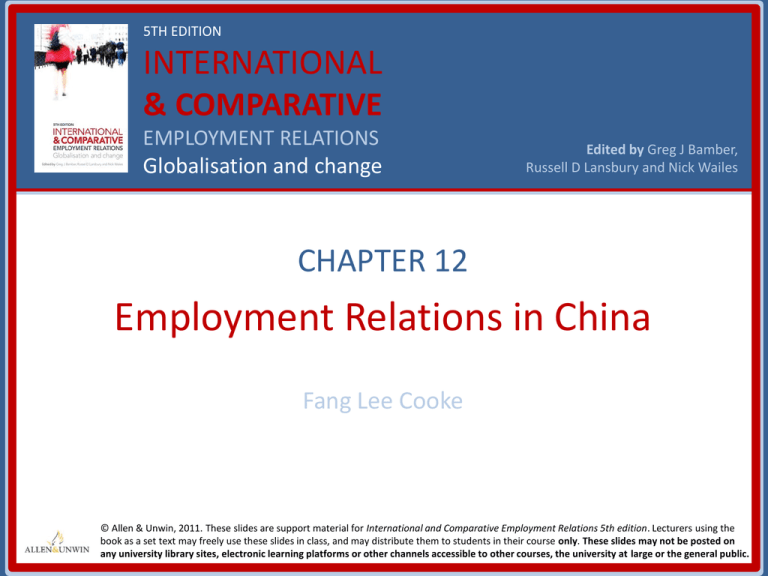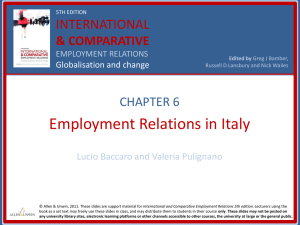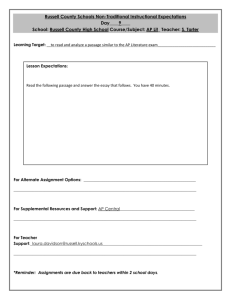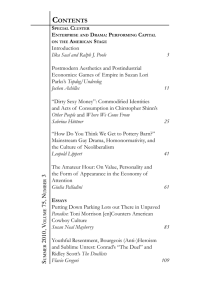China PP Slides - Sage Publications
advertisement

5TH EDITION INTERNATIONAL & COMPARATIVE EMPLOYMENT RELATIONS Globalisation and change Edited by Greg J Bamber, Russell D Lansbury and Nick Wailes CHAPTER 12 Employment Relations in China Fang Lee Cooke © Allen & Unwin, 2011. These slides are support material for International and Comparative Employment Relations 5th edition. Lecturers using the book as a set text may freely use these slides in class, and may distribute them to students in their course only. These slides may not be posted on any university library sites, electronic learning platforms or other channels accessible to other courses, the university at large or the general public. International & Comparative Employment Relations 5th edition Edited by Greg J Bamber, Russell D Lansbury & Nick Wailes Lecture outline • Context • Development of the legal framework • The changing roles of the actors – The state – Employers – Unions • • • • Collective bargaining Industrial disputes and dispute resolution Workers’ Representatives Congresses Current issues: – Labour market flexibility – Employment agencies – Working hours Chapter 12: 2 China Copyright Allen & Unwin, 2011 International & Comparative Employment Relations 5th edition Edited by Greg J Bamber, Russell D Lansbury & Nick Wailes The context of Chinese industrial relations • China has a population of over 1.3 billion, 58% of whom are in employment. • There is an uneven rate of economic development between urban and rural areas. • Women have relatively a high employment participation rate, making up 38% of full-time urban workers. • Long-term government policy has promoted low wages and full-time employment. • Social security is rudimentary and is confined mainly to urban areas. Chapter 12: 3 China Copyright Allen & Unwin, 2011 International & Comparative Employment Relations 5th edition Edited by Greg J Bamber, Russell D Lansbury & Nick Wailes Phases of labour market development The development of the labour market in China can be divided into 3 phases: • Post-1949 to late 1970s: highly restricted labour mobility through the hukou system: individuals registered with local authorities, and rural residents were not allowed to seek employment in urban areas. • 1980s to early 2000s: gradual easing of restrictions led to mass migration from rural to urban areas. Many employees in stateowned enterprises (SOEs) were laid off (27 million between 1998-2002). • Post 2007: re-regulation of the labour market to provide greater employment protection, especially for workers outside the state sector. Chapter 12: 4 China Copyright Allen & Unwin, 2011 International & Comparative Employment Relations 5th edition Edited by Greg J Bamber, Russell D Lansbury & Nick Wailes ‘Employment relations’ under the planned economy until 1979 • Employment relations under the planned economy were characterised by the ‘three old irons’: – Iron rice bowl: lifetime employment and cradle-to-grave welfare, e.g. housing, pension, healthcare provided by the state – Iron wage: centrally administered and fixed wages – Iron chair: state-controlled appointment and promotion of managers based on political orientation • Almost all enterprises were state owned. • Employment relations could be better described as a labour administration system. Chapter 12: 5 China Copyright Allen & Unwin, 2011 International & Comparative Employment Relations 5th edition Edited by Greg J Bamber, Russell D Lansbury & Nick Wailes Beginnings of the new system • China adopted an ‘open door’ economic policy in late 1970s to attract foreign investments and domestic private funds. • There was also restructuring and downsizing of SOEs and decentralisation of responsibility for personnel management to enterprise level. • New forms of ownership – Foreign-owned enterprises (FOEs), including MNCs and joint ventures (JVs) – Domestic privately-owned firms and self-employed businesses – Township and village enterprises • China joined the WTO in 2001 • Development of a ‘socialist market economy with Chinese characteristics’ Chapter 12: 6 China Copyright Allen & Unwin, 2011 International & Comparative Employment Relations 5th edition Edited by Greg J Bamber, Russell D Lansbury & Nick Wailes Changing labour laws and regulations • There has been continuing reforms of labour laws since 1980s, including the landmark new Labour Law of China (1995). • Three major employment relations laws took effect from 1 January 2008: 1. 2. 3. Labour Contract Law Employment Promotion Law Labour Disputes Mediation and Arbitration Law • In addition, the government has issued a number of regulations, e.g. Special Regulation on Minimum Wage (2004); Regulations on Employment Services and Management (2008) • The main objective of this legal framework is to achieve a more efficient and equitable labour market. Chapter 12: 7 China Copyright Allen & Unwin, 2011 International & Comparative Employment Relations 5th edition Edited by Greg J Bamber, Russell D Lansbury & Nick Wailes Characteristics of the Chinese labour laws • The central government provides the broad framework of laws and regulations. • Local governments devise their own regulations, based on the central government framework, to suit local conditions. • Flexibility is required as there is significant economic disparity across regions. • However, the decentralisation of interpretations and enforcement of labour laws means uneven application by local officials and authorities. Chapter 12: 8 China Copyright Allen & Unwin, 2011 International & Comparative Employment Relations 5th edition Edited by Greg J Bamber, Russell D Lansbury & Nick Wailes Problems of labour regulation • The most problematic aspect of Chinese labour laws is the lack of effective enforcement. • There are continuing limitations on freedom of association, e.g. the right to form independent trade unions. • Laws are targeted at the formal employment sector and not at workers in the informal sector. • Employers tend to take advantage of regulatory loopholes and seek exceptions. Chapter 12: 9 China Copyright Allen & Unwin, 2011 International & Comparative Employment Relations 5th edition Edited by Greg J Bamber, Russell D Lansbury & Nick Wailes The changing role of the state • The legacy of state planned economy is embedded in China’s political and economic system. • However, there has been a decline of state sector employment from 78% in 1978 to 23% in 2006. • The reduced state sector is due to the privatisation of SOEs, plant closures and downsizing. • There has been encouragement of foreign investment enterprises (FIEs) since the mid-1990s. • Foreign investors from Taiwan, Hong Kong and Macau have been given greater autonomy including wholly foreign-owned enterprises (FOEs). Chapter 12: 10 China Copyright Allen & Unwin, 2011 International & Comparative Employment Relations 5th edition Edited by Greg J Bamber, Russell D Lansbury & Nick Wailes The role of employers • Employer associations are not well-established. • The China Enterprise Confederation (CEC) is the sole recognised national employer body, but it plays a limited role in IR matters. • Nevertheless, employers exercise considerable influence on the government through lobbying and pressure groups, e.g. the ‘watering down’ of the draft Labour Contract Law (2008). • There are problems in private firms, FIEs and the informal sector where many workers endure ‘sweatshop’ conditions and employment regulations are violated. Chapter 12: 11 China Copyright Allen & Unwin, 2011 International & Comparative Employment Relations 5th edition Edited by Greg J Bamber, Russell D Lansbury & Nick Wailes Unions – organisation • The All China Federation of Trade Unions (ACFTU) is the sole recognised union body . • Its historical ties to the Chinese Communist Party date back to the 1920s, when grassroots union organisations served as the Party member recruitment bases and provided vital support to the Communist Party by mobilising workers. • In 2006, the ACFTU had over 1.3 million grassroots union organisations with nearly 170 million members. Chapter 12: 12 China Copyright Allen & Unwin, 2011 International & Comparative Employment Relations 5th edition Edited by Greg J Bamber, Russell D Lansbury & Nick Wailes The role of unions • The roles and responsibilities of unions are set out in the Trade Union Law (1950, amended 2001), the Labour Law (1995) and the Labour Contract Law (2008). • The unions are effectively a ‘conveyor belt’ from the Party to the workers. • Traditionally, unions’ main function has been to organise social events, take care of workers’ welfare, help management implement operational decisions, organise skills training, raise employee morale and coordinate relations between management and workers. • In recent years as SOEs have downsized, skill training and assisting laid-off workers have become major union functions. Chapter 12: 13 China Copyright Allen & Unwin, 2011 International & Comparative Employment Relations 5th edition Edited by Greg J Bamber, Russell D Lansbury & Nick Wailes Issues confronting Chinese trade unions • Attempts by ACFTU to gain greater power and autonomy have been suppressed by the Party – as have autonomous workers’ unions. • Despite increasingly conflictual relationships between management and labour, union officials remain focused on their traditional role. They generally lack the resources, power, skills and knowledge to effectively conduct collective bargaining and defend workers’ rights. • Although it is against regulations, union officials may be enterprise managers or Party secretaries or may be appointed by local governments. • Union density in the private and informal sectors remains low. Reasons for this are: – Employer resistance – Workers’ unfamiliarity with the concept of workplace representation – Workers’ perception that unions are ineffective in advancing their interests Chapter 12: 14 China Copyright Allen & Unwin, 2011 International & Comparative Employment Relations 5th edition Edited by Greg J Bamber, Russell D Lansbury & Nick Wailes Collective bargaining • The notion of ‘collective bargaining’ was first introduced into Chinese ER after the Trade Union Law (1992) authorised unions at the enterprise level to conclude collective contracts with the employer. • The term ‘collective consultation’ is preferred by the state as it conforms with values of non-confrontation and conflict avoidance. • Local authorities facilitate collective consultation between unions and employers. • Most collective contracts are made without the direct involvement of workers or any real negotiations. • Collective contracts are more widely adopted in SOEs than in private firms. Chapter 12: 15 China Copyright Allen & Unwin, 2011 International & Comparative Employment Relations 5th edition Edited by Greg J Bamber, Russell D Lansbury & Nick Wailes Labour dispute resolution • Official statistics reveal that the number of disputes referred to arbitration rose from 48 000 cases in 1996 to 317 000 cases in 2006 (vastly underestimated). • Disputes over pay and social insurance account for over half of the annual disputes. • Labour disputes appear to be increasingly confrontational and antagonistic. • The Labour Law of China (1995) established a new legal basis for settling disputes. • There are 3 stages in the labour dispute resolution system: 1. Mediation at the enterprise level through a mediation committee 2. Arbitration upon application by one of the 2 parties 3. Litigation: either party can appeal the arbitration ruling at the local People’s Court. Chapter 12: 16 China Copyright Allen & Unwin, 2011 International & Comparative Employment Relations 5th edition Edited by Greg J Bamber, Russell D Lansbury & Nick Wailes Workers’ Representatives Congresses • The worker congresses are guided by the union. • Their purpose is to facilitate worker participation in decision-making at plant level. • Like unions, they at times represent the management side and have been ineffective in protecting workers’ rights. • As such, despite this institution, there is no real partnership between management and workers or employee voice at the workplace. • The rising number of disputes referred to arbitration may be a reflection of workers’ lack of faith in unions and workers’ congresses as organisations that will safeguard their rights. Chapter 12: 17 China Copyright Allen & Unwin, 2011 International & Comparative Employment Relations 5th edition Edited by Greg J Bamber, Russell D Lansbury & Nick Wailes Labour market flexibility • The use of informal employment (e.g. temporary, seasonal, casual, and hourly-paid work) has long existed but has expanded recently. • Chinese government officially recognised the existence of ‘flexible’ (rather than informal) employment in 1996. • Displaced SOE workers and rural migrant workers comprise the majority of informal workers – approximately 150 million in urban areas. • Informal workers have no employment contract, can be hired and fired at will, are subject to mistreatment and have no job security. • The government has tended to ignore informal workers in order to provide jobs and reduce unemployment. But the problems are increasing. Chapter 12: 18 China Copyright Allen & Unwin, 2011 International & Comparative Employment Relations 5th edition Edited by Greg J Bamber, Russell D Lansbury & Nick Wailes Employment agencies • There has been significant growth in recent years at the lower end of the labour market. The number of agencies and the number of workers registered with agencies is increasing. • The Employment Agency Regulation (1995) stipulates that employment agencies must be non-profit-making if established by local authorities, but most growth is in private agencies, which can be profit-making. • Agencies can assist workers with information, training, job placement etc, but many are criticised for lack of professionalism, inadequate information and poor training. • Immediately before the new Labour Contract Law (2008) took effect and strengthened employment protection, many employers dismissed their workers and rehired them under temporary contracts, or hired new agency workers. Chapter 12: 19 China Copyright Allen & Unwin, 2011 International & Comparative Employment Relations 5th edition Edited by Greg J Bamber, Russell D Lansbury & Nick Wailes Working hours • According to official statistics, average working hours per week in the urban area have risen from 45 hours in 2003 to 47 hours in 2006. • Rural migrant workers and workers in sweatshop manufacturing plants tend to work extensive hours. • Often, such workers welcome overtime opportunities to increase their income. • Professional and managerial workers are also experiencing work intensification. Chapter 12: 20 China Copyright Allen & Unwin, 2011 International & Comparative Employment Relations 5th edition Edited by Greg J Bamber, Russell D Lansbury & Nick Wailes Conclusion • China’s IR is now diverging across different forms of ownership, industrial sectors and different groups of workers. • The role of the state continues to be crucial in shaping IR. The government desires to create a more humanistic employment environment but the intended effect of IR laws are not always achieved. • Unions retain a welfare role in the public sector but have little credibility among private sector workers where their impact is weak. • Many traditional characteristics of Chinese culture – benevolent paternalism, collectivism and harmony – are difficult to maintain in a more competitive market economy. © Allen & Unwin, 2011. These slides are support material for International and Comparative Employment Relations 5th edition. Lecturers using the book as a set text may freely use these slides in class, and may distribute them to students in their course only. These slides may not be posted on any university library sites, electronic learning platforms or other channels accessible to other courses, the university at large or the general public.









